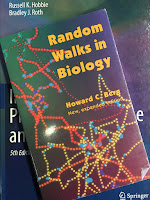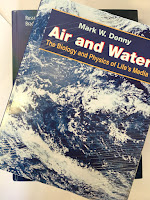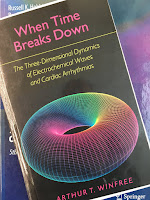In Section 12.4 of the 4th edition of
Intermediate Physics for Medicine and Biology,
Russ Hobbie and I discuss Two-Dimensional Image Reconstruction from Projections by
Fourier Transform. The method is summarized in our Fig. 12.20: i) perform a 1-D Fourier transform of the projection at each angle θ, ii) convert from
polar coordinates (
k, θ) to
Cartesian coordinates (
kx,
ky), and iii) perform an inverse 2-D Fourier transform to recover the desired image.
I wanted to include in our book some examples where this procedure could be done analytically, thinking that they would give the reader a better appreciation for what is involved in each step of the process. The result was two new homework problems in Chapter 12: Problems 23 and 24. In both problems, we provide an analytical expression for the projection, and the reader is supposed to perform the necessary steps to find the image. Both problems involve the
Gaussian function, because the Gaussian is one of the few functions for which the Fourier transform can be calculated easily. (Well, perhaps “easily” is in the eye of the beholder, but by
completing the square of the exponent the process is fairly straight forward).
I recall spending considerable time coming up with examples that are simple enough to assign as a homework problem, yet complicated enough to be interesting. One could easily do the case of a Gaussian centered at the origin, but then the projection has no angular dependence, which is dull. I tried hard to find examples that were based on functions other than the Gaussian, but never had any success. If you, dear reader, can think of any such examples, please let me know. I would love to have a third problem that I could use on an exam next time I teach medical physics.
For anyone who wants to get a mathematical understanding of image reconstruction from projections by Fourier transform, I recommend solving Problems 23 and 24. But you won’t learn everything. For instance, in
medical imaging the data is discrete, as compared to the continuous functions in these homework problems. This particularly complicates the middle step: transforming from polar to Cartesian coordinates in frequency space. Such a transformation is almost trivial in the continuous case, but more difficult using discrete data (see Problem 20 in Chapter 12 for more on that process). Nevertheless, I have found that performing the reconstruction in a couple specific cases is useful for understanding the algorithm better.
Problems 23 and 24 are a bit more difficult than the average homework problem in our book. The student needs to be comfortable with Fourier analysis. But there is something fun about these problems, especially if you are fond of treasure hunts. I find it exciting to know that there is a fairly simple function
f(
x,
y) representing an object, and that it can be determined from projections
F(θ,
x') by a simple three-step procedure. Perhaps it mimics, in a very simplistic way, the thrill that
developers of computed tomography must have felt when they were first able to obtain images by measuring projections.
If you get stuck on these two problems, contact Russ or me about obtaining the solution manual. Enjoy!
P.S. The
Oakland University website is currently undergoing some changes. For the moment, if you have trouble accessing the book website, try
http://personalwebs.oakland.edu/~roth/hobbie.htm. I hope to have a more permanent home for the website soon.







